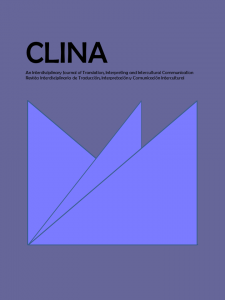[CFP] Translating and Interpreting between Chinese and Spanish in the Contemporary World. Research, Training, Professional Practice
 CURRENT CALL FOR PAPERS
CURRENT CALL FOR PAPERS
DEADLINE FOR ABSTRACT SUBMISSION (300 words approx.): 7th December, 2019.
E-MAIL: revistaclina@usal.es
DEADLINE FOR SUBMISSION OF PAPERS (for accepted abstracts):1st March, 2020.
EXPECTED DATE OF PUBLICATION: June 2020.
LIU, Jian; MARTÍN RUANO, M. Rosario and WANG, Chenying (Eds.): Translating and Interpreting between Chinese and Spanish in the Contemporary World. Research, Training, Professional Practice / La traducción e interpretación entre el chino y el español en la época contemporánea. Investigación, formación, práctica profesional
Following in the footsteps of recent issues published by the Journal, which have focused on translation and interpreting contexts that have so far received less attention from academia, this special issue will be devoted to examining the ins and outs of translation and interpreting involving Chinese and Spanish. The aim is to offer new insights into the state-of-the-art in the threefold dimension of research, training and professional practice.
Both Chinese and Spanish are undoubtedly amongst the most widely spoken languages in the world. According to the latest report by the Cervantes Institute (2019) on the role of Spanish at a global level, these languages occupy the first and second place, respectively, in the classification of languages as determined by the number of native speakers, and the second and third place, behind English, according to the total number of speakers. On the other hand, as the Elcano Report on Spain-China relations (2018) also highlights, concurrent with the significant development experienced in their national contexts, in recent decades there has been a remarkable intensification of bilateral relations between China, Spain and the rest of the Spanish-speaking countries, as well as an increasing interest in learning the Chinese language and discovering Chinese culture in Spanish-speaking contexts and vice versa. In spite of this, the volume of research devoted to studying translation between these languages in various specialised fields, to identifying the specific difficulties faced today by those who carry out translation and intercultural mediation tasks involving these languages in different professional contexts, and to reflecting on the challenges faced both by practising translators and by those who have the responsibility of training future professionals can still be described as scant.
In this context, this special issue of the journal Clina aims to serve as a platform for disseminating studies that will deepen our knowledge of the realities and challenges of the practice and teaching of translation between these two intrinsically “poly-” or “pluricentric” languages (Quesada Pacheco 2008; Rovira Esteva 2010: 271; Amorós-Negre and Prieto de los Mozos 2017) which, from “super-central” positions, interact within a system whose “hyper-central” position is indisputably occupied by English (Moreno Fernández 2015: 5). For that purpose, the concepts and approaches offered by contemporary theories of translation and other related disciplines and developed by researchers located both in the vast geography of the Spanish-speaking world on both sides of the Atlantic and on the Asian continent will be particularly useful. In addition to broadening our perspectives regarding the complex linguistic dynamics of contemporary globalisation and the processes of identity construction that take place in intercultural exchanges between the Chinese and Hispanic cultural spheres, the volume will also aim to fine-tune, enrich and diversify the theoretical-methodological basis of Translation Studies. Indeed, as more and more critical voices have been raised against certain research biases, including Eurocentrism, which may limit the development of our discipline (Tymozcko 2009; van Doorslaer and Flynn 2013), the calls to broaden the understanding of the phenomenon of translation through a greater integration of the plurality of visions, conceptions and translatological traditions that coexist around the globe have also recently gained strength.
We therefore welcome proposals for articles adopting various (inter)disciplinary approaches (linguistic, contrastive, sociological, cultural, etc.) and addressing issues including, but not limited to:
- Realities and current needs of translation: translation and intercultural mediation between Chinese and Spanish in specialised contexts (i.e., legal, scientific-technical, literary, political, tourism, industry, trade, new technologies, the media, etc.).
- Negotiation of cultures and identities in translation: analysis of translations and professional practices in different specialised domains between Chinese and Spanish, reception of authors and cultural production from China in Spanish-speaking contexts and vice versa, analysis of the dynamics of translation and cultural transfer between Spanish and Chinese in the globalised era, etc.
- Current choices and future challenges in professional practices and translator training: resources and tools available for translation, description of professional and pedagogical practices in Chinese and Spanish contexts, critical approaches, etc.
- Challenges of translation research: identification of new translation situations and new professional scenarios in the Chinese-Spanish language pair, application of translation theories of Chinese origin to the study of translation in Spanish-speaking areas, reception of Spanish-speaking translation theorists in China, etc.
References:
Amorós-Negre and Emilio Prieto de los Mozos. 2017. “El grado de pluricentrismo de la lengua española”, Language Problems and Language Planning 41(3): 245-264.
Esteban, Mario (coord.). 2018. Informe Elcano. Relaciones China-España. Madrid: Real Instituto Elcano. Available at: http://www.realinstitutoelcano.org/wps/portal/rielcano_es/publicacion?WCM_GLOBAL_CONTEXT=/elcano/elcano_es/publicaciones/informe-elcano-24-relaciones-espana-china.
Fernández-Vítores, David. 2019. El español: una lengua viva. Instituto Cervantes: Centro Virtual Cervantes. Available at: https://cvc.cervantes.es/lengua/espanol_lengua_viva/pdf/espanol_lengua_viva_2018.pdf.
Moreno-Fernández, Francisco. 2015. “La importancia internacional de las lenguas”, Informes del Observatorio de la lengua española y las culturas hispánicas en los Estados Unidos, 0010-04, doi: 10.15427/OR010-04/2015SP. Available at: http://cervantesobservatorio.fas.harvard.edu/sites/default/files/010_informes_importancia_internacional_lenguas_1.pdf.
Quesada Pacheco, Miguel Ángel. 2008. “De la norma monocéntrica a la norma policéntrica en español. Algunas reflexiones históricas según testimonios y actitudes lingüísticas”, Lecture given at the II Conference on Multiculturality and Polycentric Norm: Applications in the Teaching of Spanish as a Foreign Language. Available at: http://www.culturaydeporte.gob.es/dam/jcr:af62aaab-953a-4bc3-9e95-ec4e0f199bc0/2009-esp-09-01quesada-pdf.pdf.
Rovira-Esteva, Sara. 2010. Lengua y escritura chinas. Mitos y realidades. Barcelona: Edicions Bellaterra (Library of Contemporary China, 21).
Tymoczko, Maria. 2009. “Why translators should want to internationalize Translation Studies”, The Translator 15 (2): 401–421.
van Doorslaer, Luc and Peter Flynn (eds.). 2011. Eurocentrism in Translation Studies. Special issue of Translation and Interpreting Studies 6 (2).
